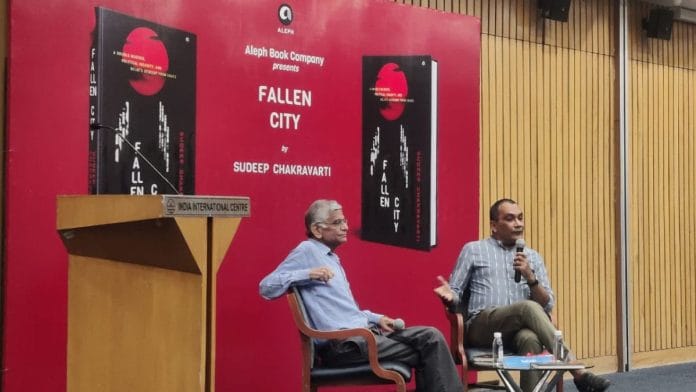New Delhi: In 1978, Delhi was gripped by fear, political instability, and riots. It was also the year when two siblings, 16-year-old Geeta and 14-year-old Sanjay Chopra, were murdered by their kidnappers, their bodies discovered in Delhi Ridge on 28 August by a cowherd. Sudeep Chakravarti goes back in time to interrogate this murder, in his book Fallen City: A Double Murder, Political Insanity, and Delhi’s Descent from Grace.
“It’s not just a story of murder,” Chakravarti said at the book launch at New Delhi’s India International Centre earlier this month. Set against the backdrop of the Emergency (it ended in 1977), and the implosions within the Janata Party when it came to power, the book explores the impact of the crime that came to be called the Ranga-Billa case.
In conversation with journalist Sunil Sethi, Chakravarti explained how he wanted to situate the murders within the larger tapestry of national trauma and transformation. The aim was to show how their deaths were part of a cycle of violence and political turmoil that shaped contemporary India.
“The book is set within the time and space, aiming to rationalise the time, killings, the people involved, and the broader context of Delhi and India during that period,” Chakravarti said.
Also read: Why BJP, Congress, and Left’s Delhi leaders are silent on RG Kar rape-murder
Persistent failures
Chakravarti wanted to show how the legal system struggled to address the brutal murders.
“The murders could have been prevented had the police control rooms moved a little more quickly,” he said. Many people saw the children struggling inside the car and the perpetrators even sought medical treatment at a local hospital, where their injuries were evident.
When the Ranga-Billa case became public, Atal Bihari Vajpayee was the foreign minister. He went to placate a large crowd of students protesting the inaction of police at Boat Club, Delhi. When he approached the students, they shouted “shame, shame” and asked him to leave.
“Things got so serious that he was stoned and struck on the forehead, leading to profuse bleeding. He was taken to the hospital, where he spent many days recovering,” said Chakravarti.
The Delhi police portrayed the perpetrators—Kuljeet Singh (alias Ranga) and Jasbir Singh (Billa)—as criminal masterminds to justify their inability to solve the case. “But they were just ambitious petty thieves looking to make a bit of money,” Chakravarti said.
Also read: Chidambaram says he is no Billa-Ranga, the convicts in 1978 crime that changed Delhi forever
Hindsight and sensitivity
Chakravarti dedicated several months to researching the case for his book. While the journalists of that era, including Prabha Dutt and Sunil Sethi, worked tirelessly to uncover and report on the case amidst a chaotic and evolving situation, Chakravarti had the advantage of hindsight and extensive archival access.
“Prabha Dutt, being the feisty journalist she was, petitioned the courts to gain access to Tihar Jail, setting a precedent for journalists to interview death row inmates,” said Chakravarti.
His research involved delving into police forensic reports, judicial records, and historical documentation to provide a comprehensive and detailed account of the crime.
He recalled sitting with Usha Rai, a reporter who covered this case, and reaching out to the mother of Geeta and Sanjay Chopra. “She was explaining to Geeta and Sanjay’s mother the purpose behind writing the book—not to sensationalise, but to tell a story of that era. Suddenly, a sharp response cut through the line: ‘No way’,” Chakravarti said.
He was careful not to exploit the children’s deaths for the book’s narrative. And the final result reflects his intentions. “I wanted to honour the memory of Geeta and Sanjay Chopra and their family,” Chakravarti said. “If they were to ever read the book, I wanted to ensure it didn’t feel like it was capitalising on their tragedy or trauma.”
Chakravarti presented the post-mortem findings with deliberate restraint, focusing on the forensic details. “It was much more about the science,” he said.
As he shared these sombre details, the audience remained silent, absorbed in the gravity of the incident.
“Why’s are psychological,” Chakravarti said, implying that the search for motives goes beyond mere facts and into the realm of human behaviour, emotions, and mental processes.
The quest for understanding the ‘why’ of the crime often falls short of addressing the deep, inexplicable pain it caused.
The tragedy is that what happened all those decades ago mirrors contemporary issues. Sethi emphasised that protests and strong reactions happen when crimes happen “people you identify with, when you have a Geeta and Sanjay, when you have a Nirbhaya, a Tilottama from Kolkata. It’s about gender outrage, the connect of familiarity, an emotional connect, a class connect.”
(Edited by Theres Sudeep)






